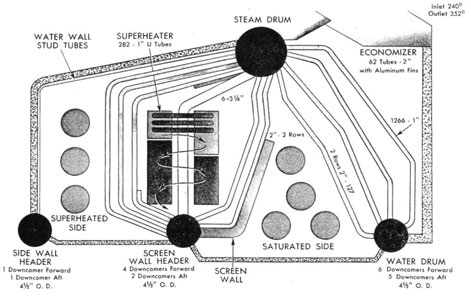That is incorrect. It is routine practice especially for warships with GTs to leave one shaft unpowered. A COGAG warship for example, will have 2 cruising speeds, one resulting from a single GT turning a single screw at near maximum output and leaving the other screw to drift (with 3 GTs offline), and a second higher cruising speed with 2 GTs at near maximum output, each turning a single screw, while the other 2 GTs are left offline.
The reason why it is advantageous to sometimes trail a unpowered shaft on a gas turbine powered vessel does not apply to steam turbine powered vessels.
In the modern world, noxious emissions from gas turbines is a major comcern. For compactness and simplicity, and because of their heritage of derivatives of airplane jet engines, Marine gas turbines are designed so the compressor feeding air into combustion chamber is rigidly geared to the turbine. Hence there is little room to adjust air intake independently of engine RPM and engine power. To maximize power output, marine turbine compressors are designed to feed the correct amount of air to the combustion chamber when the engine is at its maximum power. In this condition the combustion occurs at optimal temperature, fuel air ratio, and is most complete, clean and efficient. Conversely, when marine gas turbines operate at less than maximum power, the rigidly connected compressor will feed too much air into the combustion chamber for the combustion to use. This cools the combustion chamber below optimum temperature, resulting in incomplete combustion, high fuel wastage, and noxious emissions out the exhaust. Typically emissions from a gas turbine become prohibitively dirty at much less than 60-65% designed maximum output, and the rate of fuel consumption per kWh output substantially increases.
This is why operator do everything they can to avoid operating marine gas turbines at partial power. The advantages of operating one turbine at maximum power and training the other outweigh the advantage of operating two gas turbines at half power each and turning both shafts, for environmental and fuel efficiency reasons.
GT powered ships are not directly comparable to large 4 shaft steam turbine powered ship for the following reasons:
1. Marine boilers can independently adjust air blowers and fuel feeds, and can thus maintain efficient combustion over a wide range of power outputs. A steam powered ship does not emit significantly more pollutants or become significantly less fuel efficient per kWh out output if it runs its engine at partial power.
2. GT powered ships tend to be 2 shaft ships with high length to beam ratio, trailing one unpowered shaft create less asymmetrical thrust and less handling problems
3. GT powered ships typically can unclutch and unpowered turbine from the drive shaft, leaving the propeller shaft to spin free. Many steam turbines powered ship are not equipped to unclutch an turbine, thus trailing a unpowered shaft means either the turbine and gear box has to continue to turn under the windmilling action of the propeller, thus creating drag, or brake has to be applied to the shaft to prevent the shaft turning, creating much more drag.
Last edited:




